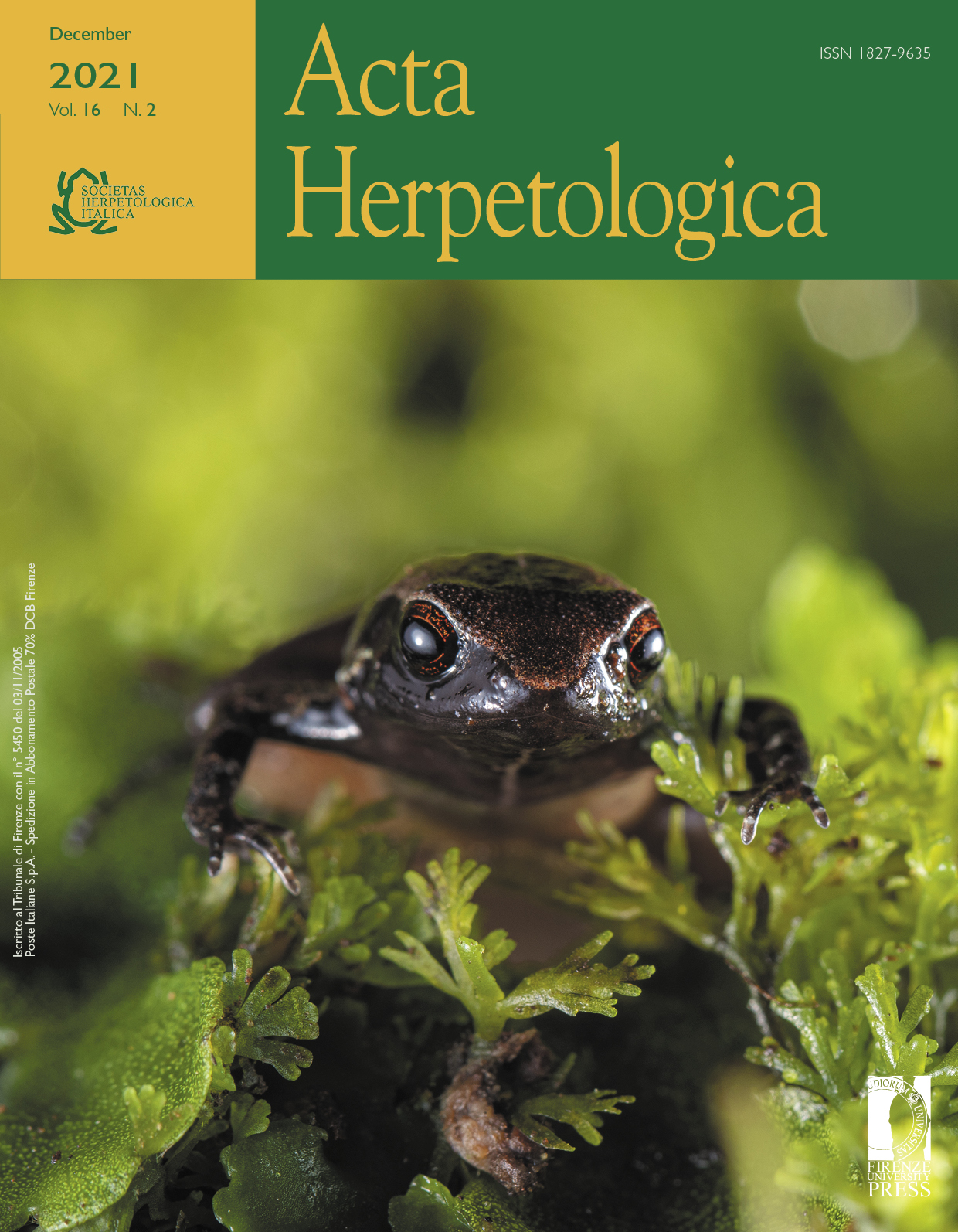Published 2021-11-01
Keywords
- APHIS,
- I³S,
- Mark-recapture,
- non-invasive,
- Snake
- Dipsadidae,
- Colubridae,
- The Bahamas ...More
How to Cite
Abstract
Photo-identification is a non-invasive option for mark-recapture. Here, we tested the effectiveness of APHIS, a semi-automated photo-identification software, to distinguish between individual Bahamian Racers (Cubophis vudii vudii) on the island of Eleuthera, The Bahamas. Over 10 months, we photographed 50 Bahamian Racers. We first identified individuals by manually comparing colouration and scale patterns in the pileus and labial regions. Next, we used APHIS to identify recaptured individuals after manually identifying the locations of intersections of the scales in the pileus and labial regions. In addition, we assessed whether images taken with a hand-held camera or by a smart phone affected the accuracy of APHIS. All recaptured snakes were correctly identified using APHIS from both camera or phone images as validated by our manually derived results. We conclude that APHIS is an effective tool for photo-identification in snakes.
Metrics
References
Besbeas, P., Freeman, S.N., Morgan, B.J.T., Catchpole, E.A. (2002): Integrating Mark-Recapture-Recovery and Census Data to Estimate Animal Abundance and Demographic Parameters. Biometrics 58: 540–547.
Brown, W.S., Parker, W.S. (1976): A Ventral Scale Clipping System for Permanently Marking Snakes (Reptilia, Serpentes). Journal of Herpetology 10: 247–249.
Carlström, D., Edelstam, C. (1946): Methods of Marking Reptiles for Identification after Recapture. Nature 158: 748–749.
Creer, D.A. (2005): Correlations between Ontogenetic Change in Color Pattern and Antipredator Behavior in the Racer, Coluber constrictor. Ethology 111: 287–300.
Gatto, C.R., Rotger, A., Robinson, N.J., Santidrián Tomillo, P. (2018): A novel method for photo-identification of sea turtles using scale patterns on the front flippers. Journal of Experimental Marine Biology and Ecology 506: 18–24.
Gibbons, W.J., Andrews, K.M. (2004): PIT Tagging: Simple Technology at Its Best. BioScience 54: 447–454.
Henderson, R.W., Powell, R. (2009): Natural history of West Indian reptiles and amphibians. University Press of Florida.
Hoefer, S., Mills, S., Pinou, T., Robinson, N.J. (2020): What the dead tell us about the living: using roadkill to analyse diet and endoparasite prevalence in Bahamian snakes. Manuscript Accepted for Publication in Ichthyology & Herpetology.
Hoefer, S., Robinson, N. J., Jones, A. (2020): Cubophis vudii vudii (Bahamian Racer). Diet. Herpetological Review, 51(2), 346–347.
Hutchens, S.J., Deperno, C.S., Matthews, C.E., Pollock, K.H., Woodward, D.K. (2008): Visible Implant Fluorescent Elastomer: A Reliable Marking Alternative for Snakes. Herpetological Review 39: 301–303.
Lunghi, E., Giachello, S., Mulargia, M., Dore, P.P., Cogoni, R., Corti, C. (2019): Variability in the dorsal pattern of the Sardinian grass snake (Natrix natrix cetti) with notes on its ecology. Acta Herpetologica 14: 141–145.
Major, T., Alkins, D.R., Jeffrey, L., Wüster, W. (2020): Marking the un-markable: visible implant elastomer in wild juvenile snakes. Herpetological Journal 30: 173–176.
Moya, Ó., Mansilla, P.L., Madrazo, S., Igual, J.M., Rotger, A., Romano, A., Tavecchia, G. (2015): APHIS: A new software for photo-matching in ecological studies. Ecological Informatics 27: 64–70.
Pradel, R. (1996): Utilization of Capture-Mark-Recapture for the Study of Recruitment and Population Growth Rate. Biometrics 52: 703–709.
Rotger, A., Colomar, V., Moreno, J.E., Parpal, L. (2019): Photo-identification of horseshoe whip snakes (Hemorrhois hippocrepis, Linnaeus, 1758) by a semi-automatic procedure applied to wildlife management. Herpetological Journal 29: 304–307.
Sacchi, R., Scali, S., Mangiacotti, M., Sannolo, M., Zuffi, M.A.L. (2016): Digital identification and analysis. In: Reptile ecology and conservation. A handbook of techniques, pp. 59–72. C. K. Dodd, Eds, Oxford University Press, Oxford.
Sacchi, R., Scali, S., Pellitteri-Rosa, D., Pupin, F., Gentilli, A., Tettamanti, S., Cavigioli, L., Racina, L., Maiocchi, V., Galeotti, P., Fasola, M. (2010): Photographic identification in reptiles: a matter of scales. Amphibia-Reptilia 31: 489–502.
Silvy, N.J., Lopez, R.R., Peterson, M.J. (2012): Techniques for Marking Wildlife. In: The Wildlife Techniques Manual, 7th ed., Vol. 1, pp. 230–257. James Hopkins University Press.
Vaughan, R. (1999): Provisional results from study of facial features as a means of individual identification in Natrix natrix. British Herpetological Society Bulletin 69: 39–46.
Weary, G.C. (1969): An Improved Method of Marking Snakes. Copeia 1969: 854–855.
Winne, C.T., Willson, J.D., Andrews, K.M. (2006): Efficacy of Marking Snakes with Disposable Medical Cautery Units. Herpetological Review 37: 52–54.






